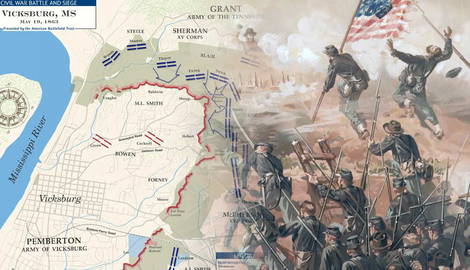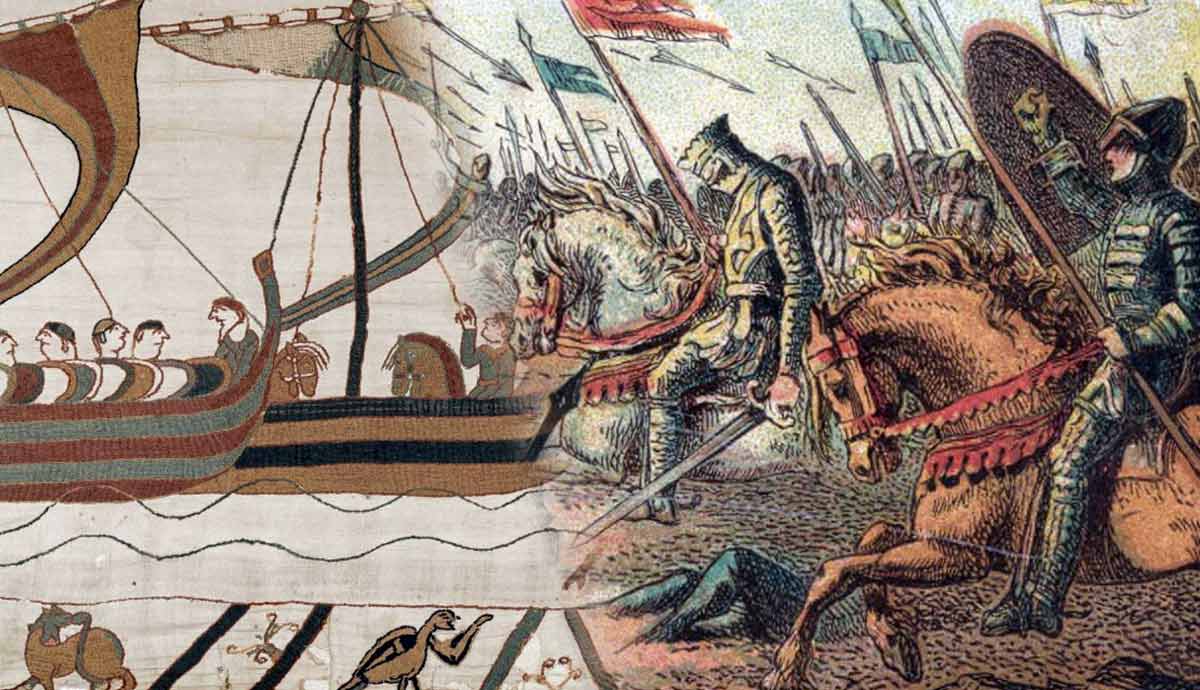
Vicksburg, Mississippi was the last Confederate stronghold on the Mississippi River in May 1863. Capturing it would prevent the Confederacy from sailing troops up and down the river to reinforce its armies. It would also represent the final success of the Anaconda Plan to place a naval blockade around the South, including the Mississippi River, to limit its transportation and trading abilities. This would, hopefully, “strangle” the Confederacy into submission.
Victory Goes to the Union

The Siege of Vicksburg ended on July 4, 1863 with a negotiated surrender by Confederate general John C. Pemberton to his Union opponent, Ulysses S. Grant. The siege had begun on May 25 after initial Union attacks on May 19. Upon the surrender of Vicksburg, the Union controlled the entire Mississippi River. This effectively split the Confederacy in two, with the states of Texas, Louisiana, and Arkansas isolated from the rest of the South. With these three states less able to send troops to reinforce the rest of the Confederacy, the Civil War was likely shortened.
Grant’s victory came at a crucial moment: Confederate general Joseph E. Johnston was arriving with 30,000 men to relieve the city when Pemberton decided to surrender on July 3. By that point, the military defenders and civilian population of the city were exhausted and in poor spirits. The previous week had seen Union attempts to capture the city by tunneling under the defensive walls and detonating explosives, creating craters that necessitated brutal hand-to-hand combat between attackers and defenders. Although Pemberton’s starving men had held firm, they knew larger Union explosions and attacks would come soon, eroding their resolve.
Timeline of the Siege of Vicksburg

The Vicksburg Campaign began in November 1862, with both Union president Abraham Lincoln and Confederate president Jefferson Davis recognizing the importance of the riverside city of Vicksburg, Mississippi. Since early 1862, Union general Ulysses S. Grant had been winning victories in the Western Theater of the war, moving closer to the Mississippi River.
By April 1863, the Union navy was able to run the river past Confederate defenses at Vicksburg, signaling that an attempt could be made to take the city with a combined naval and ground effort.
In mid-May, Grant’s forces approached Vicksburg, which was heavily defended by troops under Confederate general John C. Pemberton and almost two hundred heavy cannons within thick earthen defensive works.
On May 16, the two generals’ forces clashed for the first time east of the city. Three days later, Grant tried to storm Vicksburg by force, but failed.
On May 22, he made a second attempt, which also failed. It was decided to lay siege to the city, and the Union naval forces bombarded the city for the next 39 days.
Attempts to invade the city began again in late June. Although none of the attempts were successful, they rattled the exhausted Confederate defenders, and white flags of surrender were raised on July 3, 1863.
What Caused the Siege of Vicksburg?

After the US Civil War began with the Battle of Fort Sumter, debate erupted in Washington DC about how best to put an end to the secession. Many wanted to avoid a bloody war of attrition and hoped to pacify the Confederacy with less-direct means. Lieutenant General Winfield Scott, general-in-chief of the Union, proposed a naval blockade that would “strangle” the South by limiting its transportation and preventing foreign trade. It would also limit the possibility that a foreign power, such as Britain or France, would formally recognize and provide military aid to the Confederate States of America.
In addition to the Atlantic Ocean and Gulf of Mexico, the Confederacy also utilized the Mississippi River—the largest river in North America—to move troops and supplies north and south. Thus, the Union wanted to also seize control of the river and deny the South this easy avenue of transportation. It bombarded Vicksburg, Mississippi for the first time in 1862, after having captured New Orleans in April of that year. However, the Confederates retained control of Vicksburg, and the upper Mississippi, leading to the need for a major Union military campaign: the Vicksburg Campaign.
Why Was the Siege of Vicksburg Significant?

Abraham Lincoln considered the centrally-located Vicksburg to be the “key” to the Confederacy. If it could be captured, and give the Union control of the Mississippi River, it would symbolically break the South in two. Not only would it deny the South the use of the river, but it would let the North reopen it for trade from the upper Midwest. Since the start of the war, goods from states like Missouri, Iowa, and Illinois had not been able to travel down the river to the Gulf of Mexico for ports in Europe or Latin America. Vicksburg was also a railroad hub, the capture of which would further limit the already-weak transportation network of the Confederacy.
During the siege, the tenacity of the defenders became symbolic of the resolve of the Confederacy itself. In the First Battle of Bull Run, the Union had been surprised at the strong resistance of the Confederacy, which repelled the Union’s first attempt to seize the Confederate capital of Richmond, Virginia. As the months dragged on, Lincoln became increasingly firm in his desire to break the South’s resistance. At Vicksburg, Grant continually kept pressure on the Confederate defenders by moving his troops closer and closer to their walls and ensuring that no food or supplies could enter the city. After a Union attack on July 1, Pemberton polled his generals as to whether they should surrender, and they agreed it was the best option. This victory, made formal on July 4, made Ulysses S. Grant a national hero.
5 Facts About the Siege of Vicksburg

1. Casualties
Casualties during the Siege of Vicksburg were roughly equal in terms of soldiers killed, with both sides losing about 800 men. The Union suffered considerably more wounded, some 4,000 versus only 2,000 for the Confederates, as is expected when attacking a well-fortified defending force. Due to the surrender of the city, over 30,000 Confederate soldiers were officially listed as “captured,” though they were paroled (disarmed and sent home) rather than marched to prison camps.
2. Commanders
Union forces were led by general Ulysses S. Grant, who was coming off an impressive string of victories in the Western Theater. Grant had begun the war as a colonel in Illinois, in charge of training volunteers. After the Battle of Belmont in November 1861, Grant gained the attention of president Abraham Lincoln and was praised for his fighting spirit. At Vicksburg, Grant was aided by General William T. Sherman, who would later become famous in his own right during his March to the Sea through Georgia in 1864.
Confederate forces were led by general John C. Pemberton. Like Grant, Pemberton was a West Point graduate and veteran of the Mexican-American War. Although Pemberton was from Pennsylvania, his wife was from Virginia, which may have been why he resigned from his US Army commission in 1861 and joined the Confederacy. Pemberton’s surrender at Vicksburg, coupled with his unsavory status as a Northerner by birth, effectively ended his military career. After a year without a military position, Pemberton returned to active duty as a lieutenant colonel for the last year of the Civil War.
3. Number of Forces Involved

Under General Grant, some 77,000 Union troops faced off against just 33,000 Confederate defenders. However, despite outnumbering Pemberton more than 2-to-1, Grant was held off by strong defensive works and sheer tenacity. In the end, the complete capture of Pemberton’s army was considered a great success. To the east, victories over the Confederacy often resulted in successful Confederate retreats, leaving much of their fighting capability intact.
4. Visiting Vicksburg, Mississippi Today
Today, visitors can enjoy the Vicksburg National Military Park. The entry pass costs between ten and twenty dollars, and visitors can see a restored Civil War ironclad gunboat, the USS Cairo. Similar to the large battlefield at Gettysburg, Pennsylvania, Vicksburg has lots of monuments and memorials dedicated to individual units. On a regular basis, re-enactment activities occur at the park, such as cannon fire demonstrations.
5. Trivia: The Caves at Vicksburg
A unique aspect of the Siege of Vicksburg was the creation of a multitude of caves for both military and civilian refuge during the bombardments. The town had been targeted periodically beginning in 1862, shortly after Admiral Farragut captured New Orleans. To escape the constant threat of shells, many residents dug down into the ground. Some caves were even furnished to provide some comforts of home! Within a century after the siege, most caves had filled in and become only shallow depressions in homes’ yards. A few survived into the 1970s and became listed as historic sites.
Aftermath of Vicksburg: South Split in Two

The Union victory at Vicksburg was heralded in the press. Together, the twin victories of Vicksburg and Gettysburg, occurring almost simultaneously, were considered to turn the tide of war. Internationally, the Union used these victories to signal that the war would soon end and that any aid for the Confederacy, even humanitarian in nature, would only prolong the conflict. While foreign recognition of the Confederacy was unlikely after Lincoln’s Emancipation Proclamation following the Battle of Antietam in September 1862, the capture of Vicksburg ended any hope of it at all.
Separating Texas, Arkansas, and Louisiana from the rest of the Confederacy helped shorten the war by preventing these three states from reinforcing the remainder. Little of the Civil War was fought west of New Orleans, but this territory could have drawn out the war by sending additional troops to reinforce the Eastern Theater. The capture of Vicksburg and full control of the Mississippi River prevented this possibility, shaving months or more off the bloody conflict. Unfortunately, despite its tremendous impact on the overall strategic situation of the war, the Siege of Vicksburg is often overlooked in popular history in favor of the larger Battle of Gettysburg.










